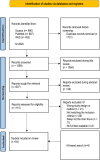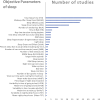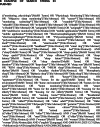Objective sleep monitoring at home in older adults: A scoping review
- PMID: 39654292
- PMCID: PMC12215280
- DOI: 10.1111/jsr.14436
Objective sleep monitoring at home in older adults: A scoping review
Abstract
Inadequate sleep in older adults is linked to health issues such as frailty, cognitive impairment and cardiovascular disorders. Maintaining regular sleep patterns is important for healthy aging, making effective sleep monitoring essential. While polysomnography is the gold-standard for diagnosing sleep disorders, its regular use in home settings is limited. Alternative objective monitoring methods in the home can offer insights into natural sleep patterns and factors affecting them without the limitations of polysomnography. This scoping review aims to examine current technologies, sensors and sleep parameters used for home-based sleep monitoring in older adults. It also aims to explore various predictors and outcomes associated with sleep to understand the factors of sleep monitoring at home. We identified 54 relevant articles using PubMed, Scopus, Web of Science and an AI tool (Research Rabbit), with 48 studies using wearable technologies and eight studies using non-wearable technologies. Further, six types of sensors were utilized. The most common technology employed was actigraphy wearables, while ballistocardiography and electroencephalography were less common. The most frequent objective parameters of sleep measured were total sleep time, wakeup after sleep onset and sleep efficiency, with only six studies evaluating sleep architecture in terms of sleep stages. Additionally, six categories of predictors and outcomes associated with sleep were analysed, including Health-related, Environmental, Interventional, Behavioural, Time and Place, and Social associations. These associations correlate with total sleep time, wakeup after sleep onset and sleep efficiency, and include in-bed behaviours, exterior housing conditions, aerobic exercise, living place, relationship status, and seasonal thermal environments.
Keywords: actigraphy; healthy aging; objective sleep monitoring; sensors; sleep; technology.
© 2024 The Author(s). Journal of Sleep Research published by John Wiley & Sons Ltd on behalf of European Sleep Research Society.
Conflict of interest statement
The authors declare no potential conflict of interest.
Figures








Similar articles
-
Home treatment for mental health problems: a systematic review.Health Technol Assess. 2001;5(15):1-139. doi: 10.3310/hta5150. Health Technol Assess. 2001. PMID: 11532236
-
Pharmacotherapies for sleep disturbances in dementia.Cochrane Database Syst Rev. 2016 Nov 16;11(11):CD009178. doi: 10.1002/14651858.CD009178.pub3. Cochrane Database Syst Rev. 2016. Update in: Cochrane Database Syst Rev. 2020 Nov 15;11:CD009178. doi: 10.1002/14651858.CD009178.pub4. PMID: 27851868 Free PMC article. Updated.
-
Community-based complex interventions to sustain independence in older people, stratified by frailty: a systematic review and network meta-analysis.Health Technol Assess. 2024 Aug;28(48):1-194. doi: 10.3310/HNRP2514. Health Technol Assess. 2024. PMID: 39252602 Free PMC article.
-
Recent Advancements in Wearable Hydration-Monitoring Technologies: Scoping Review of Sensors, Trends, and Future Directions.JMIR Mhealth Uhealth. 2025 Jun 13;13:e60569. doi: 10.2196/60569. JMIR Mhealth Uhealth. 2025. PMID: 40513095 Free PMC article.
-
Evaluating the Validity and Utility of Wearable Technology for Continuously Monitoring Patients in a Hospital Setting: Systematic Review.JMIR Mhealth Uhealth. 2021 Aug 18;9(8):e17411. doi: 10.2196/17411. JMIR Mhealth Uhealth. 2021. PMID: 34406121 Free PMC article.
Cited by
-
A Comprehensive Review of Home Sleep Monitoring Technologies: Smartphone Apps, Smartwatches, and Smart Mattresses.Sensors (Basel). 2025 Mar 12;25(6):1771. doi: 10.3390/s25061771. Sensors (Basel). 2025. PMID: 40292882 Free PMC article. Review.
References
-
- Altendahl, M. , Cotter, D. L. , Staffaroni, A. M. , Wolf, A. , Mumford, P. , Cobigo, Y. , Casaletto, K. , Elahi, F. , Ruoff, L. , Javed, S. , Bettcher, B. M. , Fox, E. , You, M. , Saloner, R. , Neylan, T. C. , Kramer, J. H. , & Walshid, C. M. (2020). REM sleep is associated with white matter integrity in cognitively healthy, older adults. PLoS One, 15, e0235395. 10.1371/journal.pone.0235395 - DOI - PMC - PubMed
-
- Arksey, H. , & O'Malley, L. (2007). Scoping studies: Towards a methodological framework. International Journal of Social Research Methodology, 8(1), 19–32. 10.1080/1364557032000119616 - DOI
-
- Arnal, P. J. , Thorey, V. , Debellemaniere, E. , Ballard, M. E. , Bou, A. , Guillot, A. , Jourde, H. , Harris, M. , Guillard, M. , van, P. , Chennaoui, M. , & Sauvet, F. (2020). The dreem headband compared to polysomnography for electroencephalographic signal acquisition and sleep staging. Sleep, 43(11), zsaa097. - PMC - PubMed
-
- Astara, K. , Tsimpolis, A. , Kalafatakis, K. , Vavougios, G. D. , Xiromerisiou, G. , Dardiotis, E. , Christodoulou, N. G. , Samara, M. T. , & Lappas, A. S. (2023). Sleep disorders and alzheimer's disease pathophysiology: The role of the glymphatic system. A scoping review. Mechanisms of Ageing and Development, 111899. - PubMed
Publication types
MeSH terms
LinkOut - more resources
Full Text Sources
Medical

